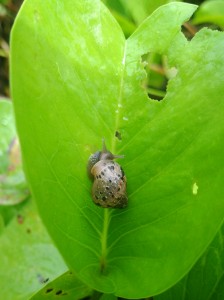
Snails and slugs feed on living plants and on decaying plant matter. They usually chew irregular holds with smooth edges in leaves and flowers, thus wreaking havoc on your in your landscape and gardens.
Snails
Snails have a coiled shell that is large enough for the animal to retract completely into. Most snails have thousands of microscopic tooth-like structures located on a ribbon-like tongue called a radula. The radula works like a file, ripping food into small pieces. Snails eat plants or algae from surfaces with their radulae and prefer a wet environment.
Slugs
Slugs are very similar to snails, however they typically lack a conspicuous shell. Some species of slugs have a reduced shell, some have only an internal vestige that serves mainly as a calcium repository, and others have no shell at all. There are however important differences in habitats and behavior. A shell-less animal is much more maneuverable and compressible, so even quite large land slugs can take advantage of habitats or retreats with very little space. Slugs squeeze themselves into confined spaces such as under loose bark on trees or under stone slabs, logs or wooden boards lying on the ground. In such retreats they are in less danger from either predators or desiccation, and often those also are suitable places for laying their eggs.